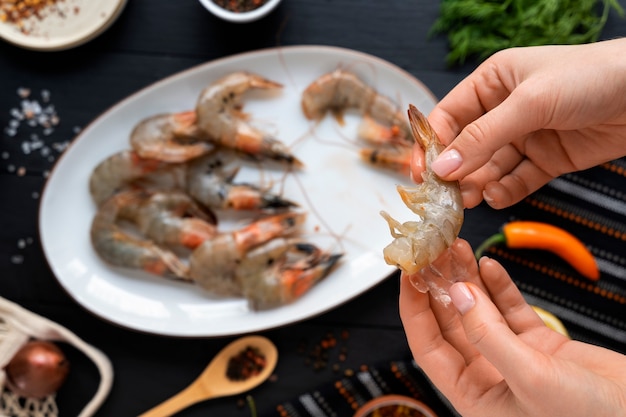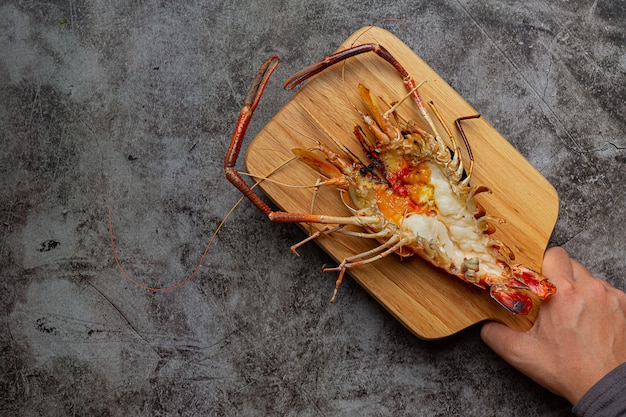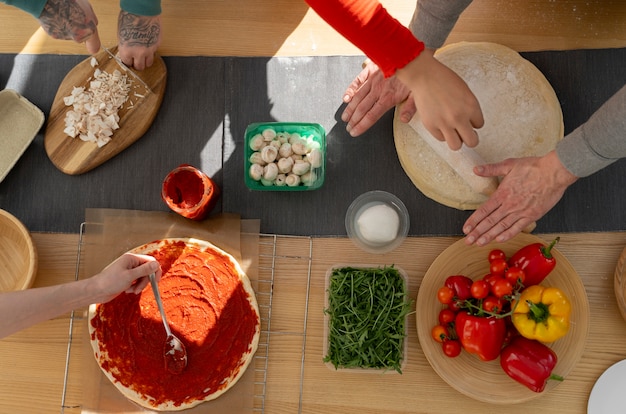Lobster. Just the word conjures images of elegant dinners, seaside feasts, and a touch of luxury. But honestly, cooking lobster doesn't have to be intimidating. It's a versatile ingredient that can be prepared in countless ways, from classic boils to creative bakes. And let me tell you, after years of experimenting in the kitchen, I've got a few tricks up my sleeve that will make you feel like a pro.
This guide is your roadmap to mastering the art of cooking lobster. We'll cover everything from picking the perfect specimen to exploring different cooking methods, and even share some of my favorite recipes. Get ready to impress your guests and delight your taste buds. So, put on your apron, grab a glass of something chilled, and let's dive in!
(Part 1) Picking Your perfect lobster

Choosing the Right Lobster: European vs. American
The first step in this culinary adventure is selecting your lobster. Now, I'm a bit of a purist, and I always lean towards European lobsters. Their delicate, sweet flavour is truly something special. They’re a bit pricier, but worth every penny in my opinion. Of course, American lobsters are readily available and offer a slightly more robust flavour. It really comes down to personal preference.
Size Matters: A Guide to Selecting the Right Size
No matter which type you choose, size is important. You want a lobster that’s heavy for its size, indicating plenty of delicious meat. Generally, lobsters weighing 1.5-2 pounds are perfect for individual servings. If you're cooking for a crowd, go for larger lobsters, 2.5-3 pounds and up.
Spotting a fresh lobster: What to Look For
The key to a delicious lobster is freshness. Here's what to look for:
Lively and Active: A healthy lobster will be energetic, moving its legs and antennae when touched.
Bright, Clear Eyes: The eyes should be clear and black, not cloudy or milky.
Firm Shell: The shell should be hard and smooth, not soft or mushy.
Clean Smell: A fresh lobster should have a fresh, ocean-like smell. Avoid any that have a fishy or ammonia-like odor.
Storing Your Lobster: Keeping it Fresh Until Cooking
Once you’ve got your prized catch, you need to keep it happy until it's time to cook.
Never Refrigerate a live lobster: The cold will kill it.
Seawater Storage: The best way to store a live lobster is in a container filled with cool, aerated seawater.
Alternative Storage: If you don't have seawater, a damp towel in a cool, dark place will do the trick for a few hours.
(Part 2) The Art of Preparing Lobster

Cleaning Your Lobster: A Necessary Step
Before you start cooking, it's time to give your lobster a little bath. This might seem intimidating, but it's really quite simple. Here's how:
Remove the Rubber Band or String: Start by cutting the rubber band or string that holds the lobster's claws together.
Shake it Out: Grab the lobster by its back legs and give it a good shake to dislodge any dirt or grit.
Remove the Stomach: You’ll find the stomach, a dark, triangular pouch, on the underside of the lobster's body. Gently pull it out with your fingers.
Preparing Lobster for Cooking: Whole vs. Split
Now, depending on your chosen cooking method, you can cook the lobster whole or split it in half.
Whole Lobster: For boiling or steaming, you can leave the lobster intact.
Split Lobster: For grilling, baking, or broiling, splitting the lobster in half helps cook it more evenly.
Splitting a Lobster: A Simple Technique
To split a lobster, place it on a cutting board, underside facing up. Use a sharp chef’s knife and cut through the centre of the lobster, from head to tail. Be careful not to cut all the way through the shell, leaving the two halves connected at the back.
Safety First: Handling Live Lobsters
Remember, live lobsters can be strong and their claws can give a nasty pinch! Always handle them with care and wear a pair of kitchen gloves for extra protection.
(Part 3) The Boiling Method: A Classic for a Reason

boiling lobster: The Simple Yet Effective Method
Boiling is the most traditional and straightforward way to cook lobster. It yields a tender, juicy meat and captures the essence of the ocean.
Large Pot: Start with a large pot filled with water. Add a generous amount of salt and a splash of white wine for flavour.
Bring to a Boil: Heat the water until it reaches a full, rolling boil.
Lower the Lobster: Carefully lower the lobster into the boiling water. Use a large spoon or a slotted spatula to help guide it.
Boiling Time: A Guide for Perfect Lobster
The boiling time depends on the size of the lobster. Here's a handy guide:
| Lobster Size | Boiling Time |
|---|---|
| 1-1.5 lbs | 10-15 minutes |
| 1.5-2 lbs | 15-20 minutes |
| 2-2.5 lbs | 20-25 minutes |
Checking for Doneness: The Skewer Test
Once the boiling time is up, remove the lobster from the pot. You can check for doneness by inserting a skewer into the thickest part of the tail. If it comes out easily, your lobster is ready.
Cooling the Lobster: Shock It in Ice Water
To stop the cooking process and make the lobster easier to handle, plunge it into a bowl of ice water immediately after removing it from the pot.
(Part 4) Steaming Lobster: A Lighter Option
Steaming Lobster: Retaining Flavor and Tenderness
Steaming is a gentler method that produces a more delicate, flavourful lobster. It retains the natural juices and creates a beautifully moist texture.
Large Steamer Basket: You'll need a large steamer basket and a pot with a tight-fitting lid.
Boiling Water: Fill the pot with about an inch of water and bring it to a boil.
Place the Lobster: Place the lobster in the steamer basket and lower it into the pot. Make sure the basket is above the boiling water but not touching the lid.
Steaming Time: Following the Same Guidelines
Use the same boiling time guidelines as mentioned above, depending on the size of your lobster.
Adding Flavor to Steamed Lobster: Aromatics
Enhance the flavour of your steamed lobster by adding aromatics to the boiling water. Some popular choices include:
Lemon slices: Adds a bright, citrusy flavour.
Bay leaves: Adds a subtle, earthy flavour.
Fresh herbs: Try thyme, rosemary, or parsley for a fragrant touch.
(Part 5) grilling lobster: A Summertime Delight
Grilling Lobster: A Smoky, Charred Delight
Grilling lobster brings a smoky char and a wonderful depth of flavor. It's perfect for those warm summer evenings.
Preheated Grill: Preheat your gas or charcoal grill to medium heat.
Split the Lobster: Split the lobster in half, and brush each side with melted butter or olive oil.
Grill it Up: Place the lobster halves on the grill, flesh side down. Cook for about 5-7 minutes per side, or until the meat is opaque and cooked through.
Tips for Grilling Lobster: Elevate the Flavor
Wood Chips: Add a few pieces of soaked wood chips to your grill for a smoky aroma. Applewood, hickory, or cherry wood chips work well.
Don’t Overcook: It's easy to overcook lobster on the grill, which can make it dry and tough. Keep an eye on it and remove it as soon as it’s cooked through.
(Part 6) baking lobster: A Versatile Option
Baking Lobster: Simple, Convenient, and Flavorful
Baking lobster is a hassle-free method, ideal when you don't have a grill. It's also incredibly versatile, allowing you to create flavourful variations with ease.
Preheated Oven: Preheat your oven to 400°F (200°C).
Aluminum Foil: Line a baking sheet with aluminum foil.
Split and Wrap: Split the lobster in half, place it on the baking sheet, and wrap it tightly in aluminum foil.
Baking Time: A Gentle Heat for Tenderness
Bake the lobster for 15-20 minutes, or until the meat is cooked through.
Flavorful Variations: Add Aromatics to the Foil
Enhance the flavour of your baked lobster by adding some aromatics to the foil before wrapping:
Butter and Garlic: A classic combination that adds richness and a touch of savory depth.
Herbs: Try thyme, rosemary, or parsley for a fragrant boost.
Spices: Add a pinch of paprika, chili powder, or cayenne pepper for a touch of heat.
(Part 7) lobster recipes: From Simple to Sophisticated
lobster thermidor: A Classic French Delight
Lobster Thermidor is a truly elegant dish that's perfect for special occasions.
Baked Lobster: Begin by splitting the lobster and baking the meat with a rich, creamy sauce.
Classic Thermidor Sauce: The sauce is a masterpiece of white wine, cream, egg yolks, and herbs, creating a luxurious and decadent flavour.
lobster mac and cheese: A comfort food Favourite
This dish combines the richness of lobster with the comfort of mac and cheese. It's a crowd-pleasing favourite that will warm your heart.
Pre-made or Homemade: You can use pre-made mac and cheese or make it from scratch, adding fresh lobster meat for a special touch.
cheesy goodness: The key is to use a good quality cheese, such as Gruyere, cheddar, or a blend of both.
Simple Lobster Salad: A Light and Refreshing Option
This is a great way to use leftover lobster, and it's a light and refreshing option for a summer lunch or dinner.
Simple Ingredients: Mix cooked lobster meat with mayonnaise, lemon juice, and your favorite herbs.
Variations: You can add other ingredients, such as chopped celery, red onion, avocado, or a sprinkle of capers for extra flavour.
Lobster Pasta: A Fancy Pasta Night
Lobster pasta is a classic Italian dish that adds a touch of luxury to your pasta night.
fresh pasta: Use fresh pasta, preferably linguine or fettuccine, for the best flavour and texture.
Garlic and Wine Sauce: A simple sauce made with garlic, olive oil, white wine, and a sprinkle of fresh parsley completes the dish.
lobster rolls: A New England Treat
Lobster rolls are a quintessential New England dish that are perfect for a casual picnic or a beachside lunch.
Fresh Lobster: Use fresh, cooked lobster meat for the best flavor.
Toasted Bun: Serve the lobster meat on a toasted bun, slathered with mayonnaise and a touch of butter.
(Part 8) Serving and Enjoying Your Lobster
Serving Your Lobster: Presenting Your Creation
Now, it's time to showcase your culinary masterpiece. You can serve the lobster whole or split in half.
Whole Lobster: If you're serving a whole lobster, provide a lobster cracker and a lobster pick to help your guests access the meat.
Split Lobster: Split lobsters are easier to eat, and you can arrange them on a platter or individually on plates.
Extra Serving Tips:
Melted Butter or Dipping Sauce: Offer your guests melted butter, garlic butter, lemon butter, or a classic cocktail sauce to enhance the flavour.
side dishes: Complement the lobster with side dishes like a green salad, roasted vegetables, or mashed potatoes.
Enjoying Your Lobster: Savoring the Flavour
Finally, it's time to enjoy the fruits of your labor.
Crack the Claws: Start by cracking the claws and savoring the succulent meat within.
Tender Tail: Then, move on to the tail, which is full of tender, delicious meat.
Creamy Tomalley: Don't forget the body, which contains the creamy tomalley (the lobster's liver), a rich and flavorful delicacy.
(Part 9) FAQs
1. How do I tell if a lobster is fresh?
A fresh lobster will have bright, clear eyes, a firm body, and a clean smell. It should also be active, moving its legs and antennae when you touch it. If it's sluggish or smells fishy, it's best to avoid it.
2. Can I freeze lobster?
You can freeze lobster, but it's best to freeze it cooked. To freeze cooked lobster, let it cool completely, then wrap it tightly in plastic wrap and aluminum foil. It will keep for several months in the freezer.
3. How long can I keep a lobster alive before cooking it?
You can keep a live lobster in a cool, dark place for a few days, but it’s best to cook it as soon as possible. Keeping it alive longer can compromise its quality.
4. What is the best way to cook a small lobster?
For small lobsters (under 1 pound), steaming or grilling is a good option. These methods cook the lobster quickly and gently, preserving its delicate flavour.
5. What are some good dipping sauces for lobster?
Some popular dipping sauces for lobster include melted butter, garlic butter, lemon butter, and cocktail sauce. You can also try aioli, chimichurri, or a spicy sriracha sauce.
And there you have it, my comprehensive guide to cooking lobster. From choosing the right lobster to mastering various cooking methods and enjoying delicious recipes, you're now equipped to impress your guests and savor every bite of this truly magnificent creature. Happy cooking!
Everyone is watching

Prime Rib Roast Cooking Time Chart: Per Pound Guide
Cooking TipsPrime rib roast. Just the name conjures images of lavish dinners, crackling fires, and hearty laughter. It’s ...

How Long to Bake Potatoes in the Oven (Perfect Every Time)
Cooking TipsBaked potatoes are a staple in my kitchen. They're incredibly versatile, delicious, and surprisingly easy to m...

Perfect Rice Every Time: The Ultimate Guide to Cooking Rice
Cooking TipsAs a self-proclaimed foodie, I've always been a bit obsessed with rice. It's the foundation of countless cuisi...

The Ultimate Guide to Cooking Asparagus: Tips, Techniques, and Recipes
Cooking TipsAsparagus. The mere mention of this spring delicacy conjures up images of vibrant green spears, crisp and burs...

Ultimate Guide to Cooking the Perfect Thanksgiving Turkey
Cooking TipsThanksgiving. Just the word conjures up images of overflowing tables laden with delicious food, the scent of r...
